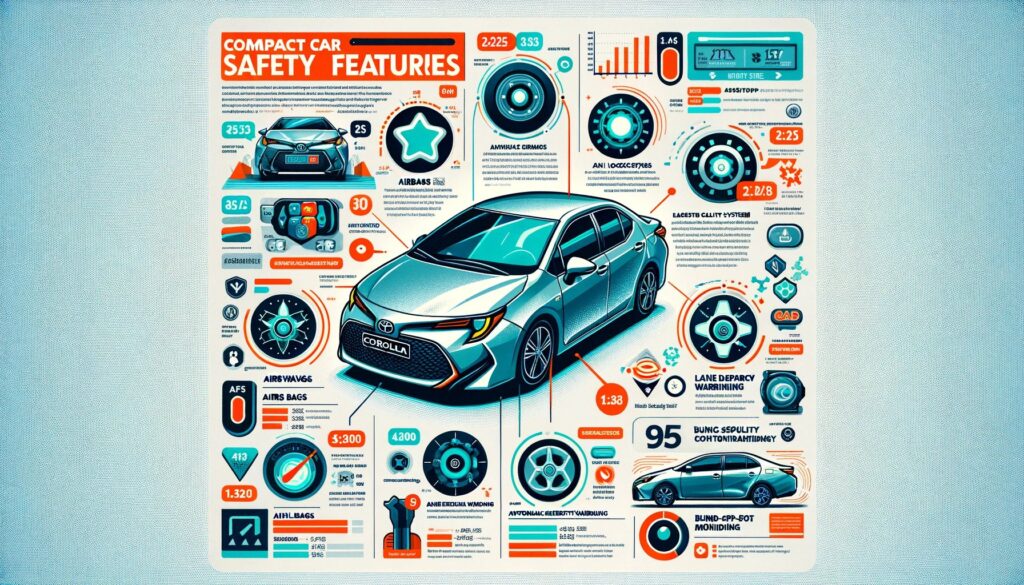In the realm of compact cars, safety features stand as paramount considerations for both manufacturers and consumers alike. Understanding the intricate details of safety ratings, common safety features, advanced safety technologies, and their impact on insurance premiums, among other factors, can significantly influence the decision-making process when purchasing a compact car.
Understanding Safety Ratings
Advanced Safety Technologies
Advanced safety technologies represent a significant evolution in automotive safety, offering enhanced collision avoidance and mitigation capabilities to improve overall road safety. Understanding these advanced safety technologies is crucial for consumers seeking to prioritize safety when choosing a compact car.
Adaptive Cruise Control
Adaptive cruise control systems revolutionize traditional cruise control by incorporating advanced sensors and radar technology to automatically adjust vehicle speed based on the distance from preceding vehicles. By maintaining a safe following distance, adaptive cruise control enhances highway safety, reduces the risk of rear-end collisions, and minimizes driver fatigue during long-distance travel. This technology offers convenience and peace of mind to drivers by seamlessly adapting to traffic flow and mitigating the need for frequent manual speed adjustments.
Lane Departure Warning (LDW)
Lane departure warning (LDW) systems are designed to alert drivers when unintentional lane departures occur, thereby helping prevent side-swipe collisions and mitigating the risk of run-off-road accidents. LDW utilizes cameras or sensors to monitor lane markings and detect deviations from the intended lane path. Upon detecting a lane departure without the use of turn signals, the system issues visual or auditory warnings to prompt driver intervention, encouraging corrective action to maintain proper lane positioning and prevent potential accidents caused by lane drifting.
Forward Collision Warning (FCW)
Forward collision warning (FCW) systems play a crucial role in collision avoidance by utilizing sensors to detect imminent front-end collisions with vehicles or obstacles ahead. Upon detecting a potential collision scenario, FCW issues visual or auditory warnings to alert the driver, providing valuable time to react and take evasive action to avoid or mitigate the severity of the impending collision. By providing timely warnings and promoting driver awareness, FCW contributes to reducing the risk of front-end collisions and enhancing overall road safety for occupants and other road users.
Automatic Emergency Braking (AEB)
Automatic emergency braking (AEB) represents a groundbreaking safety feature that can autonomously apply brakes to prevent or mitigate collisions with vehicles, pedestrians, or obstacles. AEB systems utilize sensors, such as radar or cameras, to continuously monitor the road ahead for potential collision risks. In the event of an imminent collision, the system intervenes by applying the brakes to reduce vehicle speed or bring the vehicle to a complete stop, thereby significantly reducing the severity of accidents or avoiding them altogether. AEB technology exemplifies proactive collision avoidance and is instrumental in preventing rear-end collisions and pedestrian accidents.
Pedestrian Detection System
Pedestrian detection systems utilize advanced cameras and sensors to identify pedestrians in the vehicle’s path and provide timely warnings or interventions to prevent collisions. By detecting pedestrians’ presence and movements, the system can anticipate potential collision risks and take proactive measures to mitigate them. In the event of an impending collision, the pedestrian detection system may apply brakes or issue warnings to alert the driver and reduce the risk of pedestrian-related accidents, thereby enhancing pedestrian safety and reducing the severity of injuries.
By incorporating these advanced safety technologies into compact cars, manufacturers aim to enhance collision avoidance capabilities, mitigate the severity of accidents, and improve overall road safety for drivers, passengers, and pedestrians alike.
Safety Innovations in Specific Models
Certain compact car models showcase cutting-edge safety innovations that set new standards for vehicle safety. Let’s explore two prominent examples: the Toyota Corolla and the Honda Civic.
Example 1: Toyota Corolla
The Toyota Corolla is renowned for its commitment to safety, incorporating a range of advanced safety features designed to protect occupants and prevent accidents. One standout feature of the Toyota Corolla is the Toyota Safety Sense™ suite, which encompasses several innovative technologies:
- Pre-Collision System: Utilizing advanced sensors and cameras, the pre-collision system detects potential frontal collisions with vehicles or pedestrians and issues warnings or intervenes by applying brakes to mitigate the severity of the collision.
- Lane Departure Alert with Steering Assist: This feature helps prevent unintended lane departures by issuing warnings when the vehicle drifts out of its lane without signaling. Additionally, steering assist can gently guide the vehicle back into its lane to maintain proper lane positioning.
- Dynamic Radar Cruise Control: Dynamic radar cruise control enhances highway driving safety by automatically adjusting vehicle speed to maintain a safe following distance from preceding vehicles. This feature reduces driver fatigue and enhances overall driving comfort.
- Automatic High Beams: Automatic high beams optimize nighttime visibility by automatically switching between high and low beams based on surrounding traffic conditions. This feature ensures maximum illumination of the road ahead without dazzling other drivers.
Example 2: Honda Civic
The Honda Civic exemplifies Honda’s dedication to safety innovation, offering a comprehensive suite of driver-assistive technologies known as Honda Sensing®. This suite includes the following advanced safety features:
- Collision Mitigation Braking System: The collision mitigation braking system helps prevent or mitigate frontal collisions by detecting potential collision risks and automatically applying brakes to reduce vehicle speed or avoid the collision altogether.
- Road Departure Mitigation System: The road departure mitigation system enhances safety by detecting and mitigating the risk of unintentional lane departures or roadway departures. This feature can apply corrective steering and braking to keep the vehicle on course.
- Adaptive Cruise Control with Low-Speed Follow: Adaptive cruise control with low-speed follow maintains a set following distance from preceding vehicles, even in stop-and-go traffic conditions. This feature reduces driver stress and enhances safety during congested driving situations.
- Lane-Keeping Assist System: The lane-keeping assist system helps prevent lane drift by detecting lane markings and providing steering input to keep the vehicle centered within its lane. This feature enhances stability and reduces the risk of lane departure accidents.
These innovative safety technologies embedded within the Toyota Corolla and Honda Civic exemplify the automotive industry’s commitment to advancing vehicle safety standards, providing consumers with peace of mind and confidence on the road.
Environmental Impact
Manufacturers’ commitment to utilizing eco-friendly materials in safety components and adopting sustainable production practices underscores their dedication to environmental responsibility and stewardship. This approach not only minimizes the environmental footprint of compact cars but also contributes to overall sustainability efforts within the automotive industry.
Eco-Friendly Materials in Safety Components
The incorporation of eco-friendly materials in safety components represents a proactive step towards reducing the environmental impact of compact cars. Manufacturers are increasingly utilizing sustainable alternatives to traditional materials in the production of safety features such as airbags, seat belts, and structural reinforcements. For example, recycled plastics, bio-based materials, and natural fibers are being employed to replace conventional plastics and metals, reducing resource consumption and greenhouse gas emissions associated with manufacturing processes. By prioritizing the use of eco-friendly materials, manufacturers mitigate environmental harm while maintaining the safety and integrity of vehicle safety systems.
Sustainable Production Practices
Manufacturers are embracing sustainable production practices to minimize the environmental impact of compact car manufacturing processes. From energy-efficient manufacturing facilities to waste reduction initiatives and supply chain optimization, automotive companies are implementing a range of strategies to enhance sustainability throughout the production lifecycle. By investing in renewable energy sources, improving resource efficiency, and implementing closed-loop recycling systems, manufacturers reduce their carbon footprint and conserve natural resources while producing high-quality and safe compact cars. Sustainable production practices not only benefit the environment but also foster innovation and competitiveness within the automotive industry.
Life Cycle Assessment
Life cycle assessment (LCA) plays a crucial role in evaluating the environmental impact of compact cars from production to end-of-life disposal. Manufacturers conduct LCAs to analyze the environmental implications of various materials, manufacturing processes, and transportation methods used in vehicle production. By quantifying the environmental footprint of compact cars throughout their life cycle, manufacturers can identify opportunities for improvement and implement measures to minimize environmental impact. LCAs inform decision-making processes, guiding manufacturers towards more sustainable practices and materials selection, ultimately reducing the ecological footprint of compact cars and promoting environmental stewardship.
Regulatory Compliance and Certification
Manufacturers adhere to stringent environmental regulations and certifications to ensure the sustainability of compact car production. Compliance with environmental standards such as ISO 14001 and adherence to emissions regulations promote responsible manufacturing practices and minimize adverse environmental impacts. Additionally, certifications such as LEED (Leadership in Energy and Environmental Design) for manufacturing facilities demonstrate a commitment to sustainability and environmental performance. By meeting regulatory requirements and obtaining certifications, manufacturers uphold environmental responsibility and earn consumer trust by transparently demonstrating their dedication to environmental stewardship.
Consumer Awareness and Demand
Consumer awareness and demand for eco-friendly and sustainable products are driving manufacturers to prioritize environmental considerations in compact car production. As environmentally conscious consumers seek greener alternatives, manufacturers respond by offering eco-friendly options and emphasizing sustainability in their marketing efforts. By aligning with consumer values and preferences, manufacturers not only meet market demand but also foster a culture of environmental responsibility and sustainability within the automotive industry. Consumer advocacy and support for eco-friendly practices encourage manufacturers to continually innovate and improve, leading to positive environmental outcomes and a more sustainable future for compact cars and the planet as a whole.
In conclusion, manufacturers’ commitment to utilizing eco-friendly materials, adopting sustainable production practices, conducting life cycle assessments, complying with environmental regulations, and responding to consumer demand underscores their dedication to environmental responsibility and stewardship in the production of compact cars. By prioritizing sustainability, manufacturers contribute to a greener automotive industry and promote environmental protection for present and future generations.
Regulatory Standards and Compliance
Stringent government regulations and compliance standards mandate manufacturers’ adherence to rigorous safety requirements, ensuring the highest standards of safety for compact cars. These regulations are essential for protecting consumers and promoting the development of safer vehicles that prioritize occupant protection and collision avoidance.
Government Regulations
Government agencies worldwide enact regulations and standards to govern the safety performance of compact cars and other vehicles. These regulations cover various aspects of vehicle safety, including crashworthiness, occupant protection, pedestrian safety, and emission controls. Regulatory bodies such as the National Highway Traffic Safety Administration (NHTSA) in the United States, the European Commission in the European Union, and similar agencies in other regions establish minimum safety requirements that manufacturers must meet to sell their vehicles in the market. By setting clear guidelines and standards, government regulations ensure that compact cars offer a baseline level of safety to consumers, reducing the risk of accidents and injuries on the road.
Crash Test Standards
Crash tests are a critical component of regulatory safety standards for compact cars. Regulatory agencies conduct standardized crash tests, such as frontal crash tests, side-impact tests, and rollover tests, to assess the structural integrity and crashworthiness of vehicles under controlled conditions. These tests evaluate the performance of safety features such as airbags, seat belts, and structural reinforcements in protecting occupants during collisions. Vehicles that meet or exceed prescribed performance thresholds in crash tests receive favorable safety ratings, providing consumers with valuable information about their safety performance. Manufacturers invest significant resources in designing and engineering compact cars to pass these rigorous crash tests, ensuring that their vehicles provide optimal protection in real-world crash scenarios.
Compliance Standards for Manufacturers
Manufacturers must demonstrate compliance with regulatory safety standards and specifications to certify their compact cars for sale in the market. Compliance standards cover a wide range of safety-related aspects, including vehicle design, engineering, manufacturing processes, and quality control measures. Manufacturers conduct extensive testing and validation procedures to ensure that their vehicles meet or exceed regulatory requirements for safety performance, emissions, and other key parameters. Compliance with safety standards is not only a legal requirement but also a moral and ethical obligation for manufacturers to prioritize consumer safety and uphold public trust in their products. By adhering to compliance standards, manufacturers demonstrate their commitment to producing safe and reliable compact cars that meet the highest industry standards for safety and quality.
Continuous Improvement and Innovation
Regulatory standards and compliance requirements drive continuous improvement and innovation in compact car safety. Manufacturers strive to exceed regulatory mandates by incorporating advanced safety technologies, conducting additional safety testing, and investing in research and development initiatives to enhance vehicle safety performance. As safety regulations evolve and new technologies emerge, manufacturers adapt their design and engineering practices to meet evolving safety requirements and consumer expectations. The pursuit of regulatory compliance fosters a culture of innovation and excellence within the automotive industry, leading to safer, more advanced compact cars that offer superior protection and peace of mind for consumers.
In conclusion, stringent government regulations and compliance standards play a vital role in ensuring the highest standards of safety for compact cars. By establishing clear guidelines, conducting crash tests, enforcing compliance requirements, and driving continuous improvement and innovation, regulatory agencies promote the development of safer vehicles that protect occupants and prevent accidents on the road. Compliance with safety regulations is not only a legal obligation but also a fundamental commitment to consumer safety and well-being, fostering trust and confidence in the compact car industry.
Industry Experts’ Insights
Insights from automotive safety experts provide valuable perspectives on current trends, emerging technologies, and the future direction of compact car safety, guiding consumers towards safer purchasing decisions. By tapping into the expertise of industry professionals, consumers gain a deeper understanding of the evolving landscape of automotive safety and the factors driving innovation in compact car design and engineering.
Interview with Dr. Jennifer Lee, Automotive Safety Engineer
Insights: “As automotive safety engineers, our primary goal is to design vehicles that prioritize occupant protection and collision avoidance. We’re seeing a growing emphasis on advanced driver-assistance systems (ADAS) and active safety technologies, such as automatic emergency braking and lane-keeping assist, which play a crucial role in preventing accidents and reducing injury risks. Additionally, the integration of artificial intelligence and machine learning into safety systems holds immense promise for enhancing vehicle safety and reducing accident rates. Looking ahead, I foresee continued advancements in sensor technologies, connectivity, and autonomous driving capabilities, which will further enhance the safety performance of compact cars and contribute to a future of safer and more sustainable transportation.”
Insights from John Smith, Automotive Safety Analyst
Insights: “From an industry analyst perspective, we’re witnessing a significant shift towards standardizing advanced safety features across vehicle models and brands. Features such as automatic emergency braking, forward collision warning, and lane departure warning are increasingly becoming standard equipment in compact cars, driven by consumer demand for safer vehicles and regulatory pressure to improve safety standards. Moreover, the rise of electric and hybrid compact cars presents unique opportunities for integrating safety technologies with energy-efficient propulsion systems, further enhancing overall vehicle safety and sustainability. As consumer awareness of safety features grows, manufacturers are under increasing pressure to prioritize safety in their vehicle offerings, driving innovation and competition in the compact car market.”
Opinions from Dr. Michael Chang, Automotive Safety Researcher
Insights: “As a researcher in automotive safety, my focus is on understanding the human factors involved in driving behavior and accident causation. While technological advancements in safety systems are crucial, it’s essential to consider the role of driver education, training, and behavior in promoting road safety. Human error remains a significant contributor to traffic accidents, highlighting the importance of promoting safe driving habits and addressing factors such as distraction, fatigue, and impaired driving. As we move towards greater automation and connectivity in compact cars, it’s essential to strike a balance between technological interventions and driver engagement to ensure effective and safe transportation solutions. By integrating human-centered design principles into safety systems and emphasizing driver education and awareness, we can create a safer and more sustainable driving environment for all road users.”
In conclusion, insights from automotive safety experts offer valuable perspectives on the current state and future trajectory of compact car safety. By leveraging their expertise and staying informed about emerging technologies and trends, consumers can make informed purchasing decisions and prioritize safety when selecting a compact car. The collaboration between industry professionals, researchers, and analysts drives continuous innovation and improvement in vehicle safety, ultimately contributing to a safer and more secure transportation ecosystem.
Frequently Asked Questions (FAQs)
What are the most important safety features in a compact car?
Answer:
Airbags, ABS, ESC, and advanced driver-assistance systems (ADAS) such as AEB and LDW are among the most critical safety features. These technologies enhance collision avoidance and occupant protection, reducing the risk of injury in the event of an accident.
Do all compact cars come with standard safety features?
Answer:
While many compact cars come equipped with standard safety features, the availability of advanced safety technologies may vary depending on the trim level and manufacturer. Consumers should carefully review vehicle specifications and optional safety packages when considering a compact car purchase.
How do safety ratings affect the resale value of a compact car?
Answer:
Compact cars with higher safety ratings often command higher resale values due to perceived reliability and safety benefits. Vehicles with favorable safety ratings are more attractive to prospective buyers, leading to increased demand and potentially higher resale prices in the secondary market.
Are advanced safety technologies worth the additional cost?
Answer:
Advanced safety technologies offer significant safety benefits and may translate into lower insurance premiums over time. While they may incur additional upfront costs, the potential long-term savings from accident prevention and reduced injury risks often outweigh the initial investment, making them a worthwhile consideration for many consumers.
Can safety features be added to a compact car after purchase?
Answer:
Depending on the vehicle and manufacturer, aftermarket safety upgrades such as rearview cameras and parking sensors may be available for retrofitting. These aftermarket solutions can enhance safety without the need for a new vehicle purchase, providing an opportunity for existing compact car owners to upgrade their safety capabilities.





